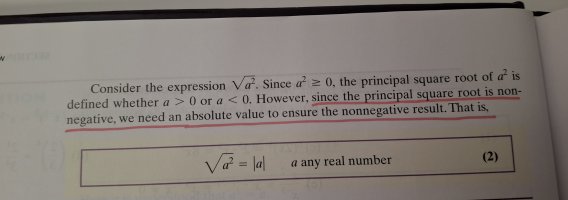mathdad
Full Member
- Joined
- Apr 24, 2015
- Messages
- 925
Michael Sullivan goes on to say this:
". . .Since the principal square root is non-negative, we need an absolute value to ensure the nonnegative result."
Let a^2 = any real number => 0.
Then sqrt{a^2} = | a |, according to the textbook. Way back in my elementary school and middle school days, math teachers NEVER taught the square root principal.
To me, the square root of any positive number or 0 is always a positive answer, especially when searching for distance.
For example, sqrt{25} = 5 and -5 back in my early childhood days. In college algebra, the sqrt{25} = | 5 | to assure a positive result.
See attachment.
When does taking the square root yield a positive and negative result?
". . .Since the principal square root is non-negative, we need an absolute value to ensure the nonnegative result."
Let a^2 = any real number => 0.
Then sqrt{a^2} = | a |, according to the textbook. Way back in my elementary school and middle school days, math teachers NEVER taught the square root principal.
To me, the square root of any positive number or 0 is always a positive answer, especially when searching for distance.
For example, sqrt{25} = 5 and -5 back in my early childhood days. In college algebra, the sqrt{25} = | 5 | to assure a positive result.
See attachment.
When does taking the square root yield a positive and negative result?


